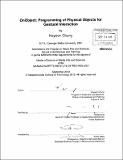OnObject : programming of physical objects for gestural interaction
Author(s)
Chung, Keywon
DownloadFull printable version (20.02Mb)
Other Contributors
Massachusetts Institute of Technology. Dept. of Architecture. Program in Media Arts and Sciences.
Advisor
Hiroshi Ishii.
Terms of use
Metadata
Show full item recordAbstract
Tangible User Interfaces (TUIs) have fueled our imagination about the future of computational user experience by coupling physical objects and activities with digital information. Despite their conceptual popularity, TUIs are still difficult and time-consuming to construct, requiring custom hardware assembly and software programming by skilled individuals. This limitation makes it impossible for end users and designers to interactively build TUIs that suit their context or embody their creative expression. OnObject enables novice end users to turn everyday objects into gestural interfaces through the simple act of tagging. Wearing a sensing device, a user adds a behavior to a tagged object by grabbing the object, demonstrating a trigger gesture, and specifying a desired response. Following this simple Tag-Gesture-Response programming grammar, novice end users are able to transform mundane objects into gestural interfaces in 30 seconds or less. Instead of being exposed to low-level development tasks, users are can focus on creating an enjoyable mapping between gestures and media responses. The design of OnObject introduces a novel class of Human-Computer Interaction (HCI): gestural programming of situated physical objects. This thesis first outlines the research challenge and the proposed solution. It then surveys related work to identify the inspirations and differentiations from existing HCI and design research. Next, it describes the sensing and programming hardware and gesture event server architecture. Finally, it introduces a set of applications created with OnObject and gives observations from user participated sessions.
Description
Thesis (S.M.)--Massachusetts Institute of Technology, School of Architecture and Planning, Program in Media Arts and Sciences, 2010. Cataloged from PDF version of thesis. Includes bibliographical references (p. 142-145).
Date issued
2010Department
Program in Media Arts and Sciences (Massachusetts Institute of Technology)Publisher
Massachusetts Institute of Technology
Keywords
Architecture. Program in Media Arts and Sciences.